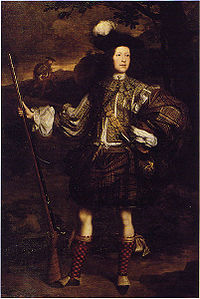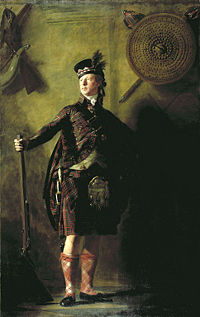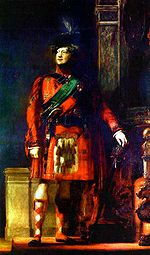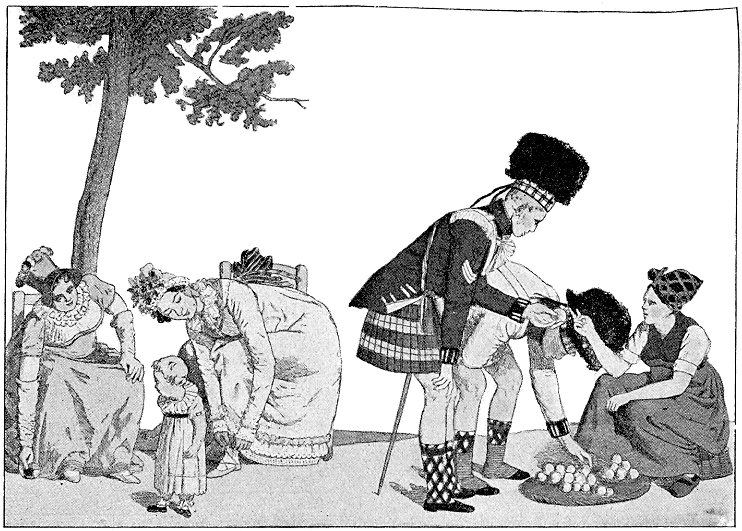
History of the kilt
Encyclopedia

Kilt
The kilt is a knee-length garment with pleats at the rear, originating in the traditional dress of men and boys in the Scottish Highlands of the 16th century. Since the 19th century it has become associated with the wider culture of Scotland in general, or with Celtic heritage even more broadly...
first appeared as the belted plaid or great kilt, a full length garment whose upper half could be worn as a cloak
Cloak
A cloak is a type of loose garment that is worn over indoor clothing and serves the same purpose as an overcoat; it protects the wearer from the cold, rain or wind for example, or it may form part of a fashionable outfit or uniform. Cloaks are as old as human history; there has nearly always been...
draped over the shoulder, or brought up over head as a cloak. The small kilt or walking kilt (similar to the 'modern' kilt) did not develop until the late 17th or early 18th century, and is essentially the bottom half of the great kilt.
The word kilt comes from the Scots
Scots language
Scots is the Germanic language variety spoken in Lowland Scotland and parts of Ulster . It is sometimes called Lowland Scots to distinguish it from Scottish Gaelic, the Celtic language variety spoken in most of the western Highlands and in the Hebrides.Since there are no universally accepted...
word kilt meaning to tuck up the clothes around the body, although the 11th edition of the Encyclopedia Britannica (vol. 15, p. 798) says the word is Scandinavian in origin. The Scots word derives from the Old Norse
Old Norse
Old Norse is a North Germanic language that was spoken by inhabitants of Scandinavia and inhabitants of their overseas settlements during the Viking Age, until about 1300....
kjalta, from Norse settlers who wore a similar, pleated garment.
The great kilt

Chemise
The term chemise or shift can refer to the classic smock, or else can refer to certain modern types of women's undergarments and dresses...
, as was the style in Ireland. This earlier cloak or brat may have been plain in colour or in various check or tartan designs, depending on the wealth of the wearer; this earlier fashion of clothing had not changed significantly from that worn by Celtic warriors in Roman times.
Over the course of the 16th century, with the increasing availability of wool, the cloak had grown to such a size that it began to be gathered up and belted. The belted plaid
Belted plaid
The belted plaid is a large blanket-like piece of fabric which is wrapped around one's body with the material pleated or, more accurately, loosely gathered and secured at the waist by means of a belt...
was originally a length of thick woollen cloth made up from two loom widths sewn together to give a total width of 54 to 60 inches, and up to 7 yards (6.4 m) in length. This garment, also known as the great kilt, was gathered up into pleats by hand and secured by a wide belt
Belt (clothing)
A belt is a flexible band or strap, typically made of leather or heavy cloth, and worn around the waist. A belt supports trousers or other articles of clothing.-History:...
. The upper half could be worn as a cloak
Cloak
A cloak is a type of loose garment that is worn over indoor clothing and serves the same purpose as an overcoat; it protects the wearer from the cold, rain or wind for example, or it may form part of a fashionable outfit or uniform. Cloaks are as old as human history; there has nearly always been...
draped over the left shoulder, hung down over the belt and gathered up at the front, or brought up over the shoulders or head for protection against weather. It was worn over a leine (a full sleeved garment stopping below the waist) and could also serve as a camping blanket. The solid colour léine
Chemise
The term chemise or shift can refer to the classic smock, or else can refer to certain modern types of women's undergarments and dresses...
of the Irish
Ireland
Ireland is an island to the northwest of continental Europe. It is the third-largest island in Europe and the twentieth-largest island on Earth...
were also often soaked in goose
Goose
The word goose is the English name for a group of waterfowl, belonging to the family Anatidae. This family also includes swans, most of which are larger than true geese, and ducks, which are smaller....
grease to make them waterproof.
A description from 1746 states:
- "The garb is certainly very loose, and fits men inured to it to go through great fatigues, to make very quick marches, to bear out against the inclemency of the weather, to wade through rivers, and shelter in huts, woods, and rocks upon occasion; which men dressed in the low country garb could not possibly endure."
For battle it was customary to take off the kilt beforehand and set it aside, the Highland charge
Highland charge
The Highland charge was a battlefield shock tactic used by the clans of the Scottish Highlands which incorporated the use of firearms.-Historical Development :...
being made wearing only the léine or war shirt. The exact age of the great kilt is still under debate. Some claim it had existed at the beginning of the 16th century. Earlier carvings or illustrations prior to the 16th century appearing to show the kilt may show the Leine Croich, a knee-length shirt
Shirt
A shirt is a cloth garment for the upper body. Originally an undergarment worn exclusively by men, it has become, in American English, a catch-all term for almost any garment other than outerwear such as sweaters, coats, jackets, or undergarments such as bras, vests or base layers...
of leather
Leather
Leather is a durable and flexible material created via the tanning of putrescible animal rawhide and skin, primarily cattlehide. It can be produced through different manufacturing processes, ranging from cottage industry to heavy industry.-Forms:...
, linen
Linen
Linen is a textile made from the fibers of the flax plant, Linum usitatissimum. Linen is labor-intensive to manufacture, but when it is made into garments, it is valued for its exceptional coolness and freshness in hot weather....
or canvas
Canvas
Canvas is an extremely heavy-duty plain-woven fabric used for making sails, tents, marquees, backpacks, and other items for which sturdiness is required. It is also popularly used by artists as a painting surface, typically stretched across a wooden frame...
, heavily pleated and sometimes quilted as protection. The earliest written source that definitely describes the belted plaid or great kilt comes from 1594. The great kilt is mostly associated with the Scottish highlands, but was also used in poor lowland rural areas. Widespread use of this type of kilt continued into the 19th century, and some still wear it today.
The small kilt or walking kilt

A letter published in the Edinburgh Magazine in March 1785 by one Ivan Baillie argued that the garment people would today recognize as a kilt was invented around the 1720s by Thomas Rawlinson, a Quaker
Religious Society of Friends
The Religious Society of Friends, or Friends Church, is a Christian movement which stresses the doctrine of the priesthood of all believers. Members are known as Friends, or popularly as Quakers. It is made of independent organisations, which have split from one another due to doctrinal differences...
from Lancashire
Lancashire
Lancashire is a non-metropolitan county of historic origin in the North West of England. It takes its name from the city of Lancaster, and is sometimes known as the County of Lancaster. Although Lancaster is still considered to be the county town, Lancashire County Council is based in Preston...
. Rawlinson was claimed to have designed it for the Highlanders who worked in his new charcoal
Charcoal
Charcoal is the dark grey residue consisting of carbon, and any remaining ash, obtained by removing water and other volatile constituents from animal and vegetation substances. Charcoal is usually produced by slow pyrolysis, the heating of wood or other substances in the absence of oxygen...
production facility in the woods of northern Scotland
Scotland
Scotland is a country that is part of the United Kingdom. Occupying the northern third of the island of Great Britain, it shares a border with England to the south and is bounded by the North Sea to the east, the Atlantic Ocean to the north and west, and the North Channel and Irish Sea to the...
. After the Jacobite campaign of 1715 the government was "opening" the Highlands to outside exploitation and Rawlinson was one of the businessmen who took advantage of the situation. It was thought that the traditional Highland kilt, the "belted plaid" which consisted of a large cloak, was inconvenient for tree cutters. He supposedly brought the Highland garment to a tailor, intent on making it more practical. The tailor responded by cutting it in two. Rawlinson took this back and then introduced the new kilt. Rawlinson liked the new creation so much that he began to wear it as well and was soon imitated by his Scottish colleagues, the Clan MacDonnell of Glengarry
Clan MacDonnell of Glengarry
Clan MacDonell of Glengarry is a branch of Clan Donald taking its name from Glen Garry where the river Garry runs eastwards through Loch Garry to join the Great Glen about 16 miles north of Fort William...
.
This story has become well known, due in part to the historian Hugh Trevor-Roper's work, but more recent evidence has shown this theory to be out of date as several illustrations have been found of Highlanders wearing only the bottom part of the belted plaid that date long before Rawlinson ever set foot in Scotland. There is some suggestion of its use in the 1690s, and it was definitely being worn by the early 18th century. It most likely came about as a natural evolution of the belted plaid and Rawlinson probably observed it and quickly deduced its usefulness in his situation and insisted on introducing it among his workers. So while it may well be the case that Rawlinson promoted the philabeg, he is no longer credited with inventing it.
The first instance we have of the pleats being sewn in to the philabeg, creating a true tailored kilt, comes in 1792. This kilt, currently in the possession of the Scottish Tartans Authority http://www.tartansauthority.com, is the first garment that can truly be called a 'modern' kilt as we know it today. Up until this point, the kilt was folded, rather than pleated. This development served to speed the donning of the kilt and was brought into use by the Scottish regiments serving in the British Army. The tailored military kilt and its formalised accessories then passed to the civilian market during the early 19th century and has remained popular ever since.
Proscription and revival of the kilt


Jacobite rising
The Jacobite Risings were a series of uprisings, rebellions, and wars in Great Britain and Ireland occurring between 1688 and 1746. The uprisings were aimed at returning James VII of Scotland and II of England, and later his descendants of the House of Stuart, to the throne after he was deposed by...
s demonstrated the dangers to central government of such warrior Highland clans, and as part of a series of measures the government of King George II
George II of Great Britain
George II was King of Great Britain and Ireland, Duke of Brunswick-Lüneburg and Archtreasurer and Prince-elector of the Holy Roman Empire from 11 June 1727 until his death.George was the last British monarch born outside Great Britain. He was born and brought up in Northern Germany...
imposed the "Dress Act" in 1746, outlawing all items of Highland dress including kilts (although an exception was made for the Highland Regiments) with the intent of suppressing highland culture. The penalties were severe; six months' imprisonment for the first offense and seven years' transportation for the second. The ban remained in effect for 35 years.

Romanticism
Romanticism was an artistic, literary and intellectual movement that originated in the second half of the 18th century in Europe, and gained strength in reaction to the Industrial Revolution...
s to wear kilts as a form of protest against the ban. This was an age that romanticized "primitive" peoples, which is how Highlanders were viewed. Most Lowlanders had viewed Highlanders with fear before 1745, but many identified with them after their power was broken. The kilt, along with other features of Gaelic culture, had become identified with Jacobitism
Jacobitism
Jacobitism was the political movement in Britain dedicated to the restoration of the Stuart kings to the thrones of England, Scotland, later the Kingdom of Great Britain, and the Kingdom of Ireland...
, and now that this had ceased to be a real danger it was viewed with romantic nostalgia.
Once the ban was lifted in 1782, Highland landowners set up Highland Societies with aims including "Improvements" (which others would call the Highland clearances
Highland Clearances
The Highland Clearances were forced displacements of the population of the Scottish Highlands during the 18th and 19th centuries. They led to mass emigration to the sea coast, the Scottish Lowlands, and the North American colonies...
) and promoting "the general use of the ancient Highland dress". The Celtic Society of Edinburgh, chaired by Walter Scott
Walter Scott
Sir Walter Scott, 1st Baronet was a Scottish historical novelist, playwright, and poet, popular throughout much of the world during his time....
, encouraged lowlanders to join this antiquarian enthusiasm. Also in Ireland, any form of Gaelic customs was outlawed by the Penal laws.
The kilt became identified with the whole of Scotland with the pageantry of the visit of King George IV to Scotland
Visit of King George IV to Scotland
The 1822 visit of King George IV to Scotland was the first visit of a reigning monarch to Scotland since 1650. Government ministers had pressed the King to bring forward a proposed visit to Scotland, to divert him from diplomatic intrigue at the Congress of Verona.The visit increased his popularity...
in 1822, even though 9 out of 10 Scots now lived in the Lowlands. Scott and the Highland societies organised a "gathering of the Gael" and established entirely new Scottish traditions, including Lowlanders wearing a stylised version of the traditional garment of the Highlanders. At this time many other traditions such as clan identification by tartan were developed (prior to this, tartans were identified with regions, not specific clans).
After that point the kilt gathered momentum as an emblem of Scottish culture as identified by antiquarians, romantics, and others, who spent much effort praising the "ancient" and natural qualities of the kilt. King George IV had appeared in a spectacular kilt, and his successor Queen Victoria
Victoria of the United Kingdom
Victoria was the monarch of the United Kingdom of Great Britain and Ireland from 20 June 1837 until her death. From 1 May 1876, she used the additional title of Empress of India....
dressed her boys in the kilt, widening its appeal. The kilt became part of the Scottish national identity
Scottish national identity
Scottish national identity is a term referring to the sense of national identity and common culture of Scottish people and is shared by a considerable majority of the people of Scotland....
and the wider Celtic identity.
Military use

Scottish regiment
A Scottish regiment is any regiment that at some time in its history has or had a name that referred to Scotland or some part, thereof, and adopted items of Scottish dress...
regiment in 1739 their great kilt uniform was standardised with a new dark tartan.
Many Jacobite
Jacobitism
Jacobitism was the political movement in Britain dedicated to the restoration of the Stuart kings to the thrones of England, Scotland, later the Kingdom of Great Britain, and the Kingdom of Ireland...
rebels adopted kilts as an informal uniform, with even their English supporters wearing tartan items during the Jacobite Rising
Jacobite rising
The Jacobite Risings were a series of uprisings, rebellions, and wars in Great Britain and Ireland occurring between 1688 and 1746. The uprisings were aimed at returning James VII of Scotland and II of England, and later his descendants of the House of Stuart, to the throne after he was deposed by...
of 1745. In the aftermath of that rebellion the Government decided to form more Highland regiments for the army in order to direct the energies of Gaels, that "hardy and intrepid race of men". In doing so they formed effective new army regiments to send to fight in India
India
India , officially the Republic of India , is a country in South Asia. It is the seventh-largest country by geographical area, the second-most populous country with over 1.2 billion people, and the most populous democracy in the world...
, North America
North America
North America is a continent wholly within the Northern Hemisphere and almost wholly within the Western Hemisphere. It is also considered a northern subcontinent of the Americas...
, and other locations while lowering the possibility of rebellion at home. Army uniforms were exempt from the ban on wearing kilts in the "Dress Act", and as a means of identification the regiments were given different tartans. These regiments opted for the modern kilts for dress uniforms, and while the great kilt remained as undress uniform this was phased out by the early 19th century.
Many Scottish units wore kilts in combat during WWI. In particular, the ferocious tactics of the Royal Highland Regiment
Black Watch
The Black Watch, 3rd Battalion, Royal Regiment of Scotland is an infantry battalion of the Royal Regiment of Scotland. The unit's traditional colours were retired in 2011 in a ceremony led by Queen Elizabeth II....
led to their acquiring the nickname "Ladies from Hell" from the German troops that faced them in the trenches. The Highland Regiments entered WWII wearing the kilt, but it was rapidly recognized as impractical for modern warfare and was last worn in action at the evacuation of Dunkirk in May 1940. However, on D-Day
D-Day
D-Day is a term often used in military parlance to denote the day on which a combat attack or operation is to be initiated. "D-Day" often represents a variable, designating the day upon which some significant event will occur or has occurred; see Military designation of days and hours for similar...
, June 1944, Lord Lovat
Simon Fraser, 15th Lord Lovat
Brigadier Simon Christopher Joseph Fraser, 15th Lord Lovat and 4th Baron Lovat DSO, MC, TD was the 25th Chief of the Clan Fraser and a prominent British Commando during the Second World War...
, commander of 1 Special Service Brigade, was accompanied by his personal piper Bill Millin
Bill Millin
William "Bill" Millin , commonly known as Piper Bill, was personal piper to Simon Fraser, 15th Lord Lovat, commander of 1 Special Service Brigade at D-Day.- Early life :...
, who wore a kilt – and also played the bagpipes –- while German bullets whizzed around him.
The kern
Kern (soldier)
A Kern was a Gaelic soldier, specifically a light infantryman in Ireland during the Middle Ages.-Linguistic roots:The word kern is an anglicisation of the Middle Irish word ceithern or ceithrenn meaning a collection of persons, particularly fighting men. An individual member is a ceithernach...
s of gaelic Ireland wore the long léine, or "saffron shirt" (often misinterpreted as a kilt in depictions) may have had connections with the predecessor of the modern kilt. This tradition has been continued in the pipe bands of the Republic of Ireland's defence forces.

